| HOME |
|---|
URSA MAJOR
The Big Bear
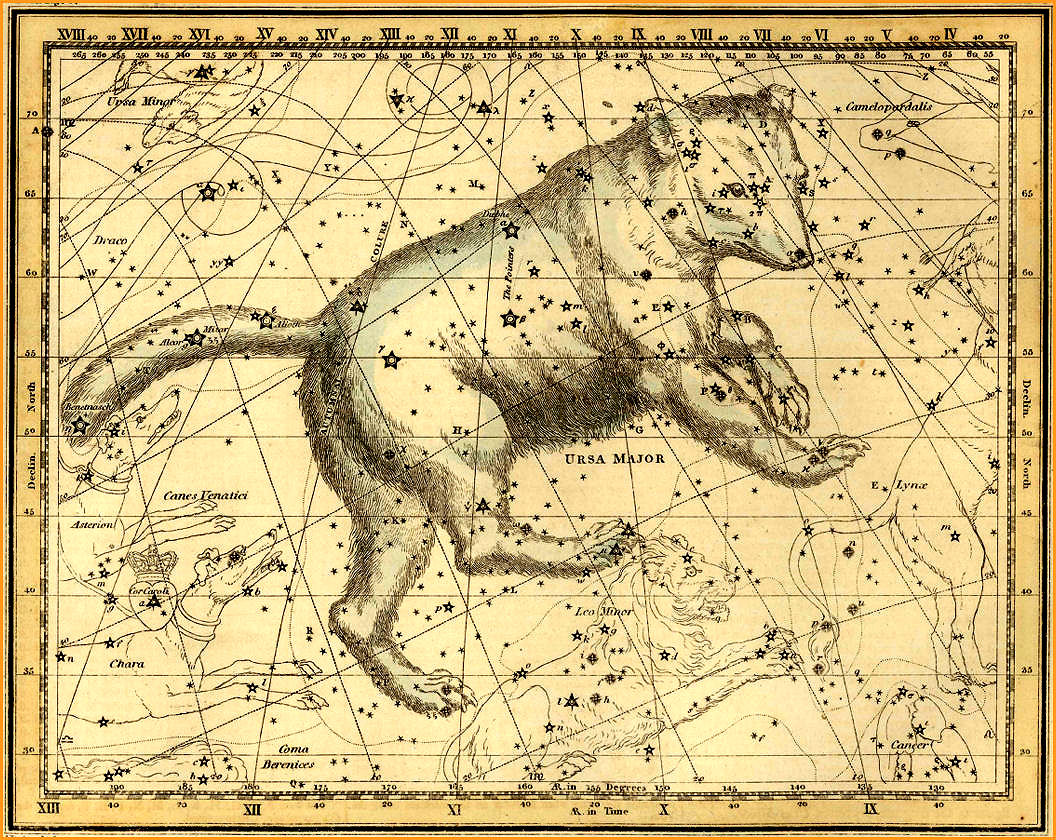
Ursa Major - Celestial Atlas by Alexander Jamieson - 1822
| HOME |
|---|

The most recognizable grouping of stars in the night sky has to be the Big Dipper. It is known in different cultures as different things, including a plow, a wagon, and a chariot, but it's always recognised as something. It's just too big and bright and distinctive to be ignored.
But the Big Dipper is not an official constellation. It is only an asterism, or a grouping of stars, within the constellation Ursa Major, the big bear. Ursa Major is the third largest constellation in the heavens, recognized as the figure of a bear throughout history. Classic writers all the way back to Homer have identified the stars with a bear.
In Greek myth, the great bear was originally a beautiful maiden named Callisto, who caught the ever roving eye of the mighty Zeus (Jupiter), king of the gods. In a jealous rage, Zeus's wife, Hera (Juno), turned Callisto into a bear. When Callisto moved to embrace her young son, Arcas, he saw only a great bear rushing toward him, and prepared to shoot it with an arrow. When Zeus saw this tragedy unfolding he quickly turned the young Arcas into a bear as well, and grabbing them both by their tails, he hurled them into the sky, safe from the wrath of his wife. In the words of the scribe Ovid:
But Hera had the final spiteful word, and made sure the bears landed in the northern sky, close enough to the north star (Polaris), that they would never be able to set, and rest below the horizon, as almost all the other constellations did. Callisto and her son, Arcas, would be condemned to circle endlessly around Polaris for eternity.
The force with which Zeus threw these heavy animals into the sky is said to have stretched their tails, resulting in their unnatural length. In the ancient lore of native North Americans the bear has the normal short tail, and the three stars trailing behind it are viewed as three hunters, tracking the great bear.
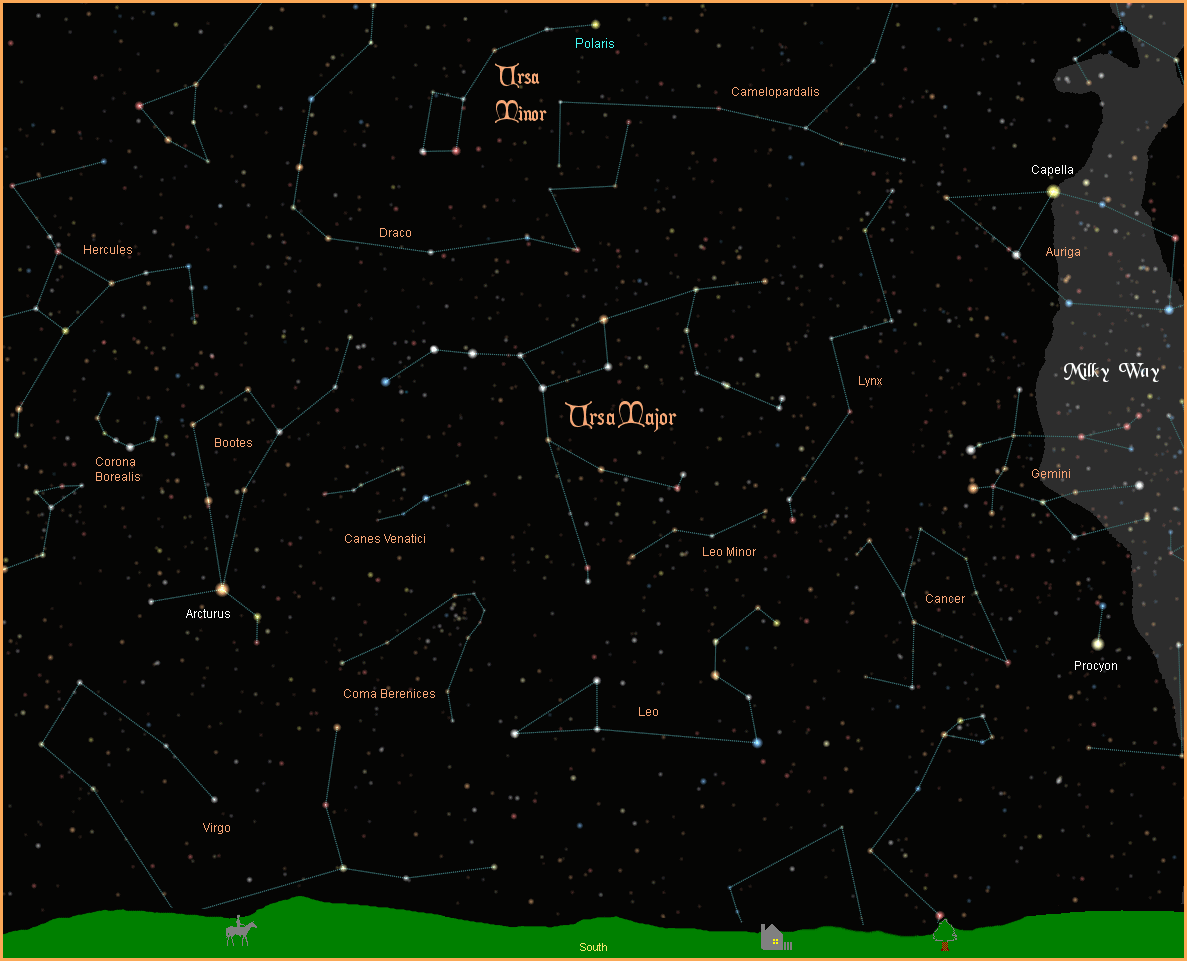
Back in 1603, when Johannes Bayer allotted his Greek letter designations to the stars of Ursa Major, he used geography as opposed to brightness as his priority. In honour perhaps to their prominence throughout the ages, he lettered the seven bright stars of the big dipper first, from west to east, the order in which they cross the sky.
On the dipper's front rim is Alpha Ursae Majoris, named Dubhe, from the Arabic for bear. It is a G8III yellow/orange giant, 123 light years away. At magnitude 1.81, it is the second brightest star in the constellation. Along with Merak it is the northerly of the two pointing stars that have traditionally shown the way to the north star, Polaris.
Below Dubhe is Beta Ursae Majoris, named Merak, from the Arabic for loin. It is the southerly of the two pointer stars, an A1IV white subgiant, 79.7 light years away, with a magnitude of 2.37.
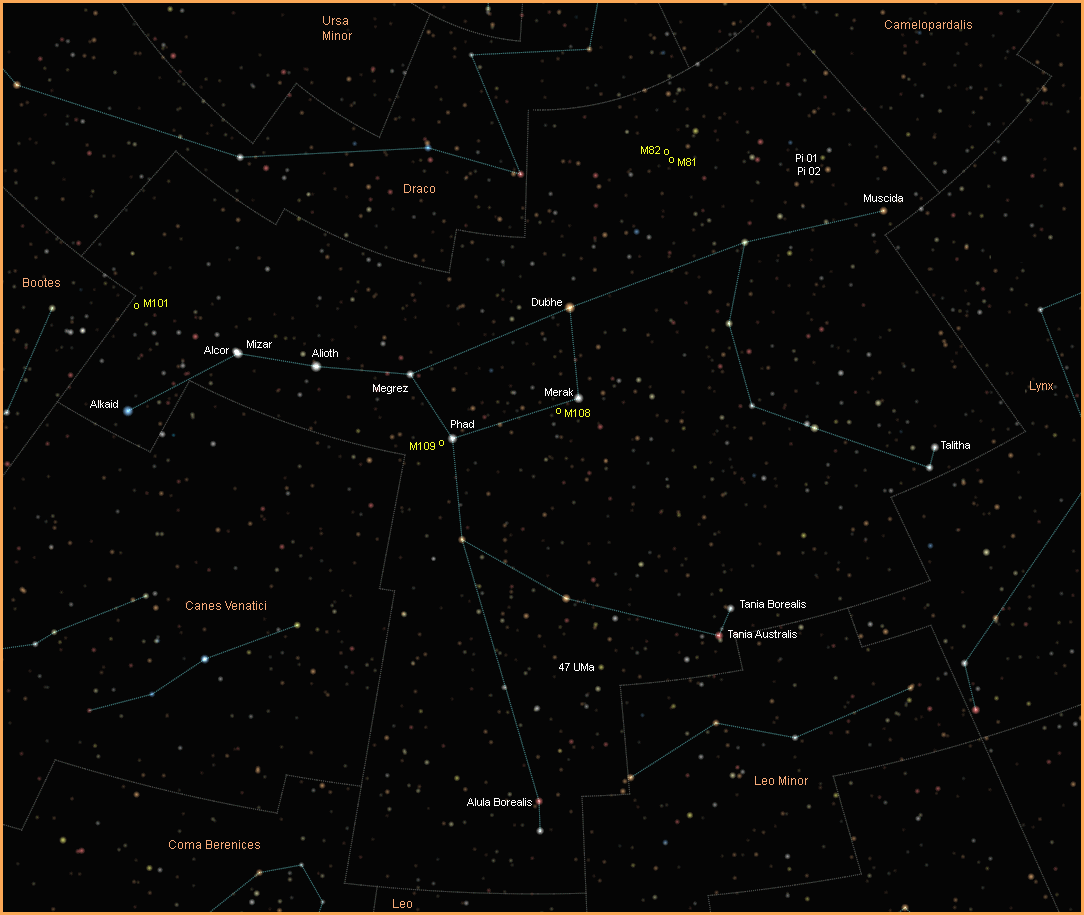
Moving eastward we have Gamma Ursae Majoris, named Phad, from the Arabic for thigh. Similar to Merak, it is an A1IV white subgiant, 83.2 light years away, with a magnitude of 2.41.
Next in line is Delta Ursae Majoris, named Megrez, from the Arabic for root of the tail. Very like its two predecessors, it is an A2 white main sequence star, 80.5 light years away. At magnitude 3.32 Megrez is the faintest of the stars in the big dipper.
Moving eastward along the handle/tail to Epsilon Ursae Majoris, named Alioth, from the Arabic for fat tail. Continuing the trend, it is another A1IV white subgiant, 82.6 light years away, and at magnitude 1.76 it is the brightest star in the constellation.
Moving along to the star at the bend in the handle/tail, we notice right away that something doesn't look right. The star appears elongated and on closer inspection is seen to be two stars very close to each other. Keen eyes can separate them without visual aid, and the two stars have been used through the ages as a test for eyesight, the smaller of the two often referred to as "Al Sadak," Arabic for the test. Commonly known as "the horse and rider," all indications are that Mizar and Alcor are gravitationally connected, although separated by about a third of a light year and taking almost a million years to orbit each other.
The larger, brighter star is Zeta Ursae Majoris, named Mizar, from the Arabic for waist, which seems oddly misplaced - the waist of the tail perhaps. Mizar is a quadruple star system, two close binaries that orbit each other every 5,000 years. All four stars are A1V class white main sequence stars, with a combined magnitude of 2.40.
The smaller, dimmer star was not allotted a Bayer designation, but traditionally named Alcor, which is of obscure origins, possibly from the Arabic "Al Khawwar," the faint one. With a magnitude of 4.02, Alcor is only half as bright as Mizar. It is an A6V white main sequence star, with a small M3 red dwarf companion, giving the entire Mizar/Alcor system a total of six stars, all located about 80 light years away.
At the end of the dipper's handle (or the tail of the bear) we find Eta Ursae Majoris, named Alkaid, or Benetnasch, from the Arabic "Kaid Banat al Na'ash," captain of the mourners, referring to an ancient vision of three mourners attending a funeral bier - the bowl of the dipper. Alkaid is the youngest of the seven dipper stars, a hot B4V blue main sequence star with a surface temperature around 17,000 degrees K. From a distance of 103 light years, it shines at magnitude 1.87, the third brightest star in the constellation.
Before the additions of the modern constellations Leo Minor and Lynx in 1687, the relatively dark area between Ursa Major and Leo was known as Al Haud, the pond. It is said that a gazelle drinking from the edge of the pond, suddenly noticed the lion on one side and the bear on the other, and bounded away in three quick jumps, leaving three sets of tracks in the mud, indicated by the three evenly spaced pairs of stars that also represent the feet of the bear.
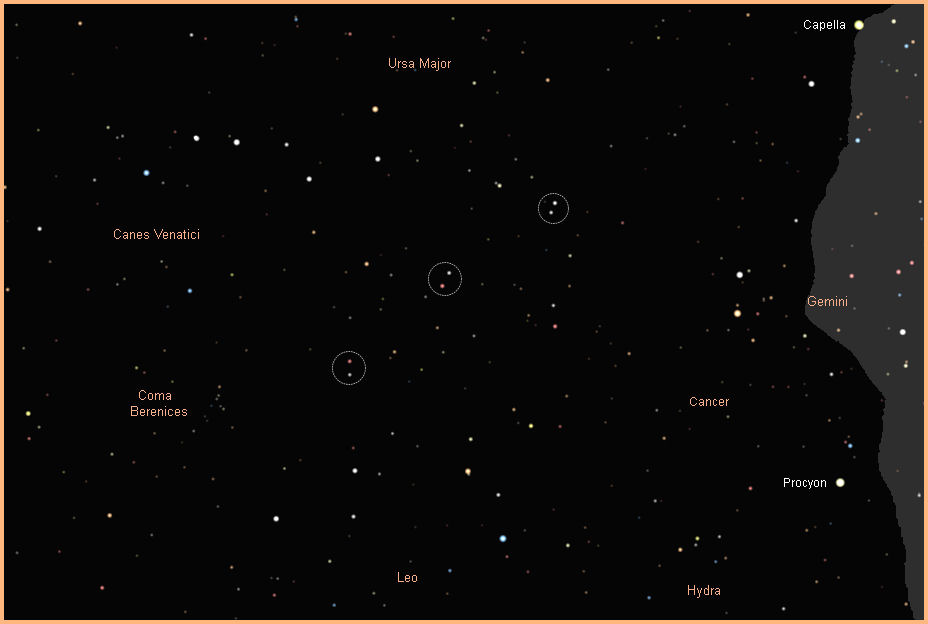
The first leap of the gazelle is denoted by the pair of stars Nu and Xi Ursae Majoris, respectively named Alula Borealis and Alula Borealis, the Arabic term "Alula" meaning the first spring. The two stars, which also mark the left hind foot of the bear, couldn't be more different, the northern component being a huge K0IV orange subgiant 70 times larger than our Sun, and over 1,000 times brighter, with a "G" class companion similar to our Sun. The binary system has a combined magnitude of 3.49, and is very far away at a distance of about 400 light years.
Conversely, the southern star, Xi Ursae Majoris, is very close, only 27 light years away. It is a binary pair of G0V yellow main sequence stars like our Sun, which both have their own smaller, dimmer companions, making up a quadruple star system with a combined magnitude of 3.78.
Lamda and Mu Ursae Majoris are Tania Borealis and Tania Australis respectively, the Arabic term "Tania" meaning the second spring. The two stars also mark the right hind foot of the bear. Tania Borealis is an A1V blue/white main sequence star, 137 light years away, with a magnitude of 3.45.
Tania Australis is almost twice as far away at 230 light years, an M0III red giant with a magnitude of 3.05.
Iota and Kappa Ursae Majoris denote the third leap of the gazelle, as well as the right front foot of the bear. Unlike the first two leaps of the gazelle, this pair of stars do not carry northern and southern designations, but are simply labelled with the Arabic Talitha, meaning the third spring. Most star charts name only the northern star, although the name is commonly applied to both stars.
Iota Ursar Majoris, the northerly of the pair, is an A7V white main sequence star with three dwarf companions, making it a quadruple system, with a magnitude of 3.12, only 47 light years away.
Kappa Ursae Majoris is a much bigger, much brighter, and much farther away, being a close binary pair of almost identicle A1III blue/white giants about 360 light years, yet still managing a respectable magnitude of 3.57.
The nose of the bear contains three stars named Muscida, an old English/Latin term for muzzle, and two of these stars have confirmed planets. The brightest of these marks the tip of the bear's nose, Omicron Ursae Majoris, at magnitude 3.35. Not particularly close at a distance of 180 light years, it is a G5III yellow giant with a very dim, very distant red dwarf companion star. It also has a large planetary companion about four times the mass of Jupiter that takes 4.5 years to orbit the star.
Nearby to the north, where the bear's eyes or forehead might be, is the second Muscida, Pi-2 Ursae Majoris, with a magnitude of 4.59, still quite visible with the naked eye on a dark night. Far away at a distance of 256 light years, it is a K1III orange giant. Coincidentally, it too has a planet, seven times the size of Jupiter, in a 270 day orbit.
Right beside it is the third and faintest Muscida, Pi-1 Ursae Majoris, with a magnitude of 5.63, necessitating the darkest of nights for naked eye viewing. Unlike the other two Muscidas, this one is quite close by, only 46.8 light years away. It is a G0V yellow main sequence star, similar to our Sun, but so far no planets have been found.
At last count there were 18 stars in Ursa Major hosting 23 planets, and no less than five of these stars are visible with the naked eye, including the two Muscidas mentioned above. By the bear's back leg is 47 Ursa Majoris, at magnitude5.05 still visible with the naked eye on a dark night. It is an exciting star because it is quite close, only 43 light years away, and has a total of three planets surrounding it, one of which is only half the size of Jupiter.
The last two stars with planets are right at the limits of naked eye visibility, observable only on the darkest of nights. HD 81688, by the bear's front leg, has a magnitude of 5.39, and is very far away at a distance of 287 light years, with a planet almost three times the size of Jupiter. HD 89744 has a magnitude of 5.72, and is found down by the bear's foot. It is 127 light years away, with a very large planet almost eight times the size of Jupiter. For more information on these and other extrasolar planets, visit NASA's New Worlds Atlas, and The Open Exoplanets Catalogue.
If you have a telescope, there are lots of good targets in Ursa Major, including no less than eight Messier objects, starting with M40, one of the more unimpressive objects Charles Messier catalogued back in 1764. So unimpressive in fact, it was considered a mistake for over 200 years, until it was rediscovered in 1966 as "Winnecke 4" or "Groombridge 1878", a pair of faint optically aligned stars with a combined magnitude of 8.4.
The only other deep sky object inside our own galaxy is a much more interesting find by Messier, M97, the Owl Nebula. It has a magnitude of 9.9, and is about 3000 light years away. It is an expanding shell of gas emitted by a central star that began to die and shed its outer layers about 6,000 years ago.
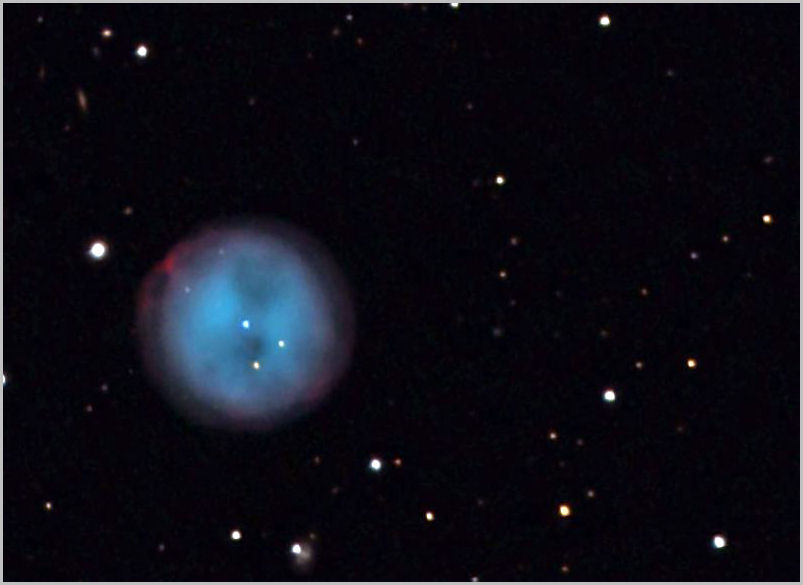
Looking past the stars of Ursa Major out into intergalactic space, we find ourselves knee deep in galaxies, many of them accessible with a smaller telescope. The biggest and the brightest of these galaxies is M81, with a magnitude of 6.94. Also known as "Bode's Galaxy" after Johann Elert Bode who discovered it along with M82 back in 1774, it is mandatory viewing for anyone with a telescope. M81 is the dominant galaxy in the M81 Group, a small gathering of 34 galaxies 11.7 million light years away. It is the next closest galaxy group to our own "local group" which contains our Milky Way galaxy. With a diameter of 97,000 light years, M81 is almost the same size as our Milky Way, and is presently interacting with nearby galaxies M82 and NGC 3077, the trio known as "the M81 triplet".
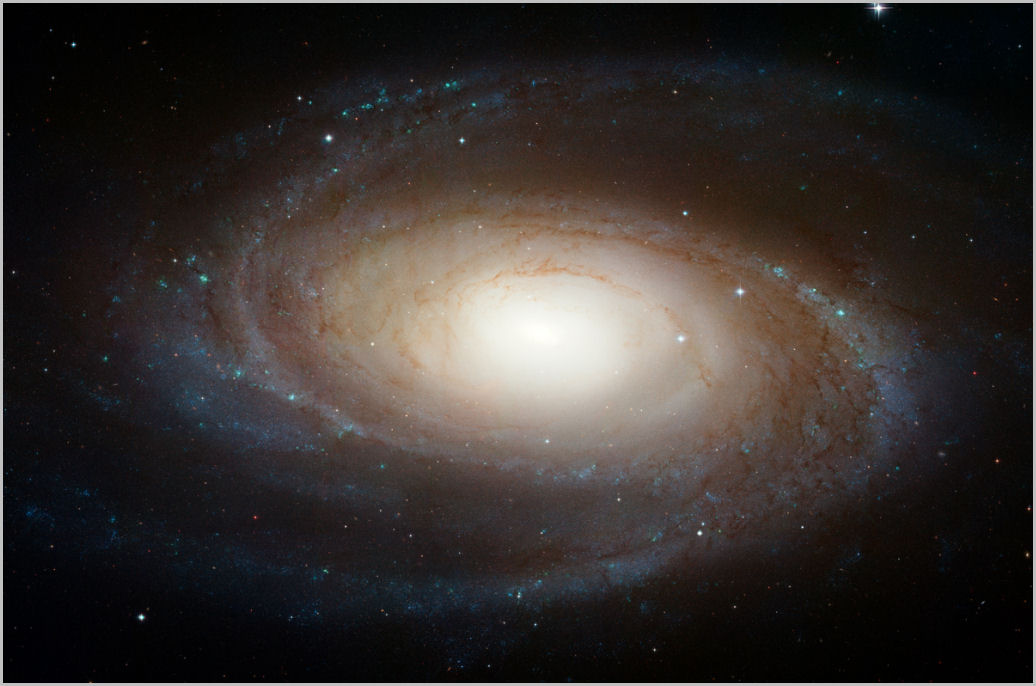
On the edge of M81 is a small, sparsely populated, yet notably picturesque satellite galaxy of the big spiral. Sparkling with young, hot, blue stars, it is named Holmberg IX, and classified as an irregular dwarf galaxy. Containing only about 20,000 stars, its dim magnitude of 16.5 means it can only be seen through the largest telescopes.
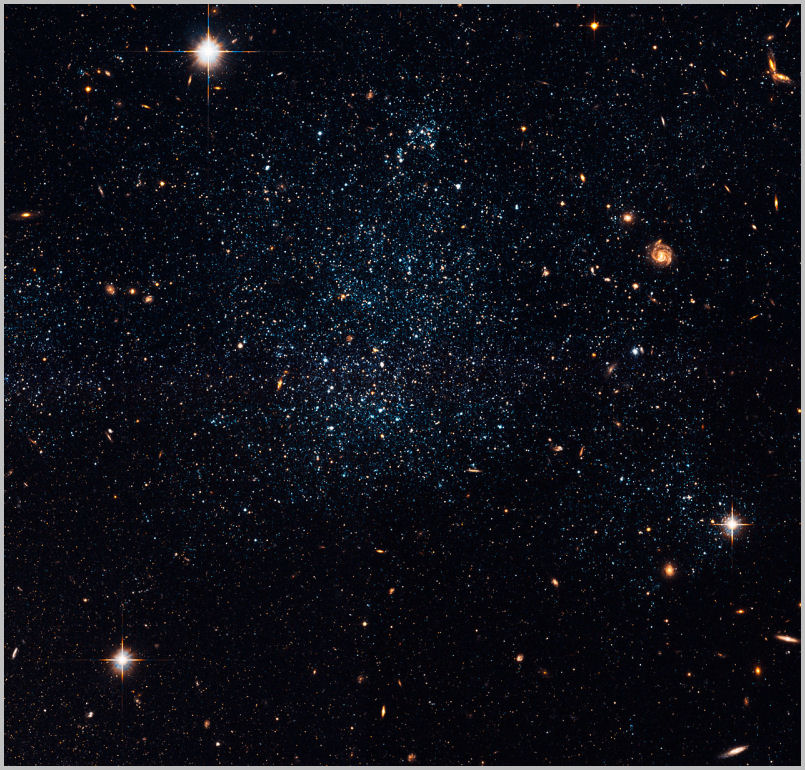
The second largest galaxy in the M81 group is M82 (NGC 3034). Measuring 37,000 light years across, it is only about 150,000 light years away from the much larger M81, allowing both of the galaxies to fit in the same telescopic field of view. Because of their proximity the gravity well of the larger galaxy is disrupting the structure of the smaller M82, and instigating a furious amount of new star formation. As a result, M82 is fairly exploding with the birth of new stars, to the point where it has become the prototype of this type of galaxy, called a Starburst galaxy. Despite the abundance of suns bursting to life within it, M82 is still decidedly dimmer than M81, with a magnitude of 8.41.
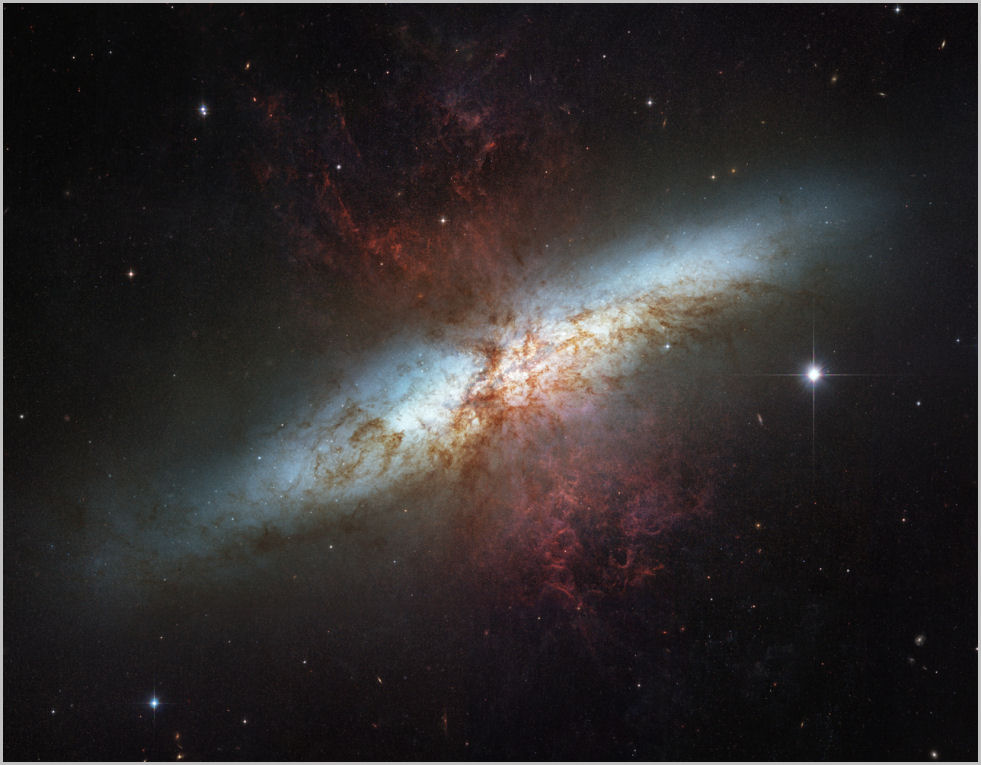
The smallest and dimmest of the M81 triplet is elliptical galaxy NGC 3077 with a magnitude of 9.9, making it a challenge to find in a small telescope. Like M82, the gravity of M81 is pulling it apart and sparking a flurry of new star formation.
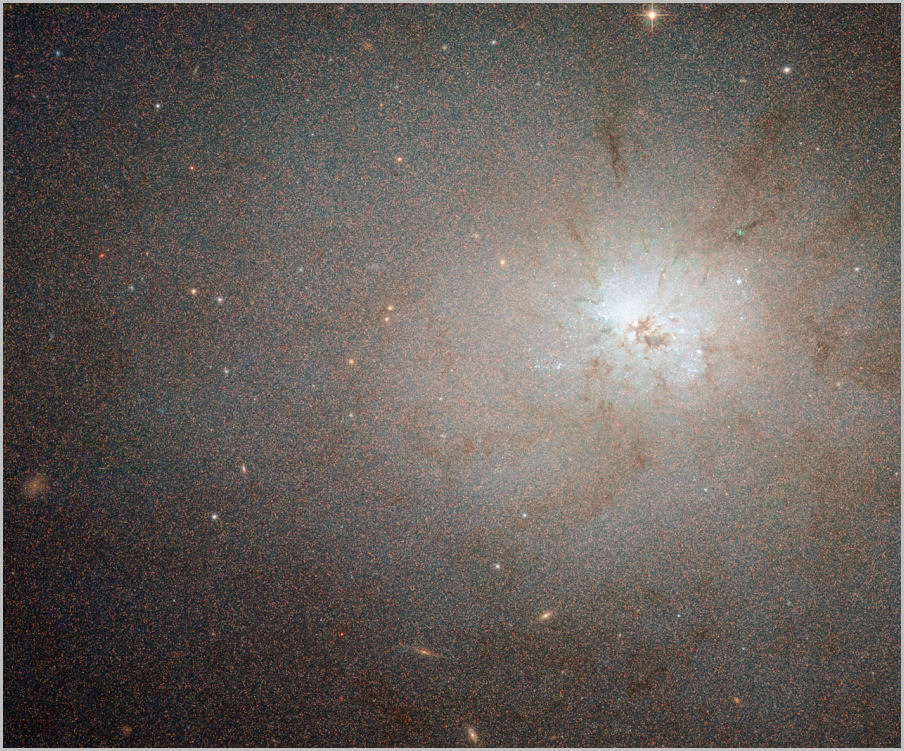
Another small dwarf galaxy within the M81 Group is UGC 5497. Looking very much like one of its smaller, more compact cousins, a globular cluster, it is thought to contain about a million stars.
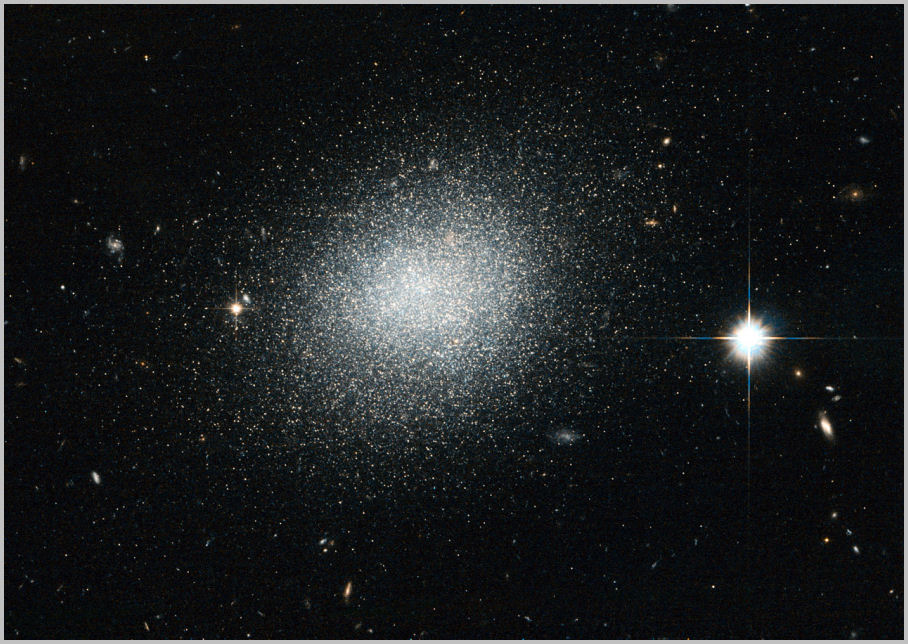
At the end of the Big Dipper's handle is M101, the spectacular Pinwheel Galaxy, a big, bright, face-on spiral with a magnitude of 7.86 and another mandatory target for all backyard scopes. Although our own Milky Way galaxy is considered one of the larger galaxies out there, M101 is a full 70 percent larger, and estimated to contain about a trillion stars. M101 is also the premier member of the M101 Group, containing eight other nearby galaxies, all much smaller and fainter, and all located about 20 million light years away.
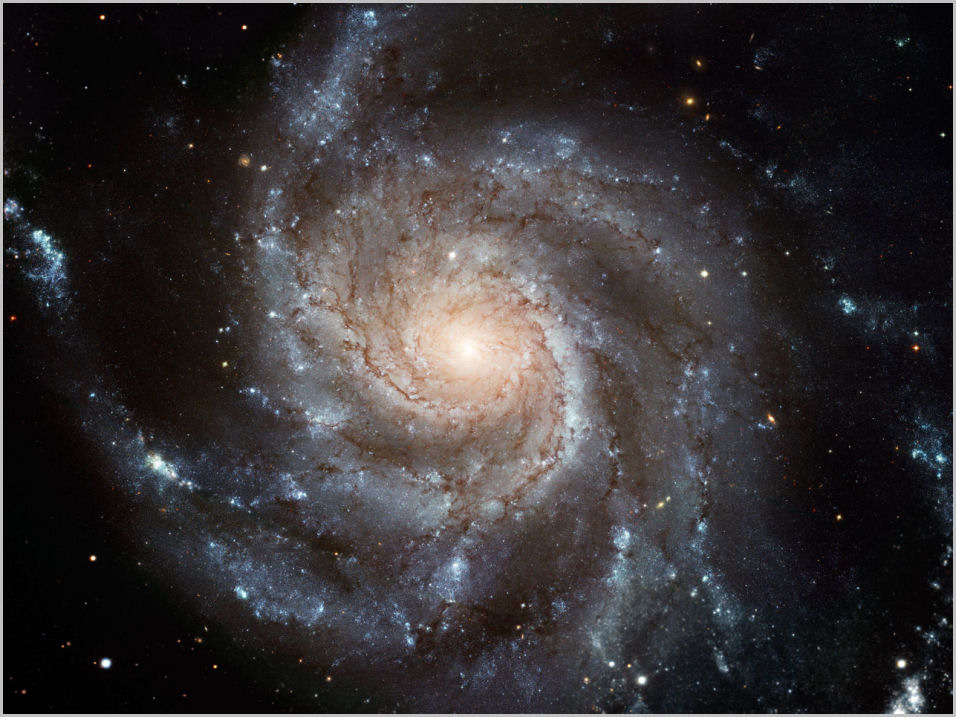
One of the members of the M101 Group is the irregular dwarf galaxy NGC 5477. At magnitude 14.0, it is accessible only through large telescopes.
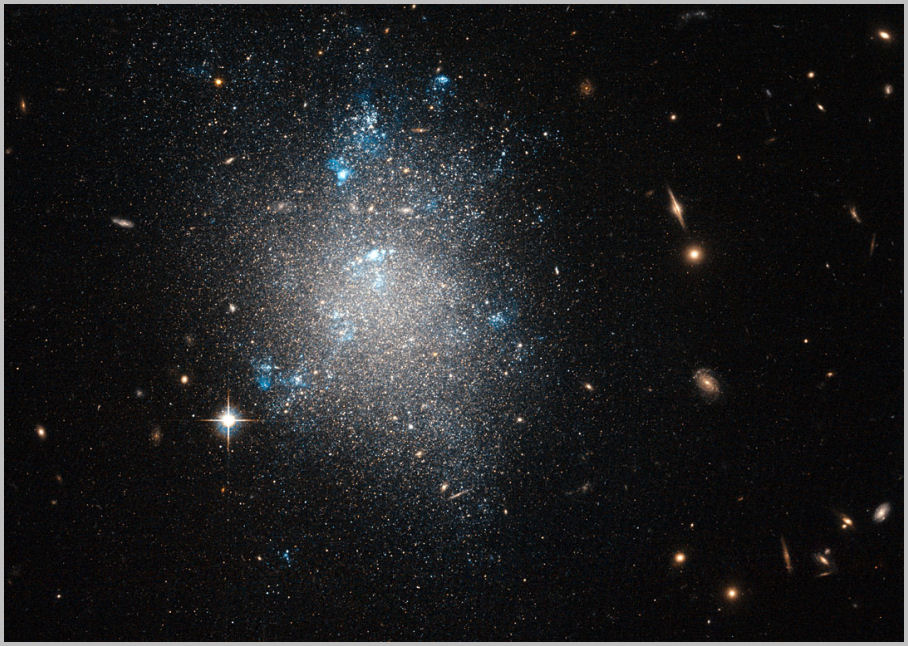
Right beside the Owl Nebula is the spiral galaxy M108, about 45 million light years away, with a magnitude of 10.0.
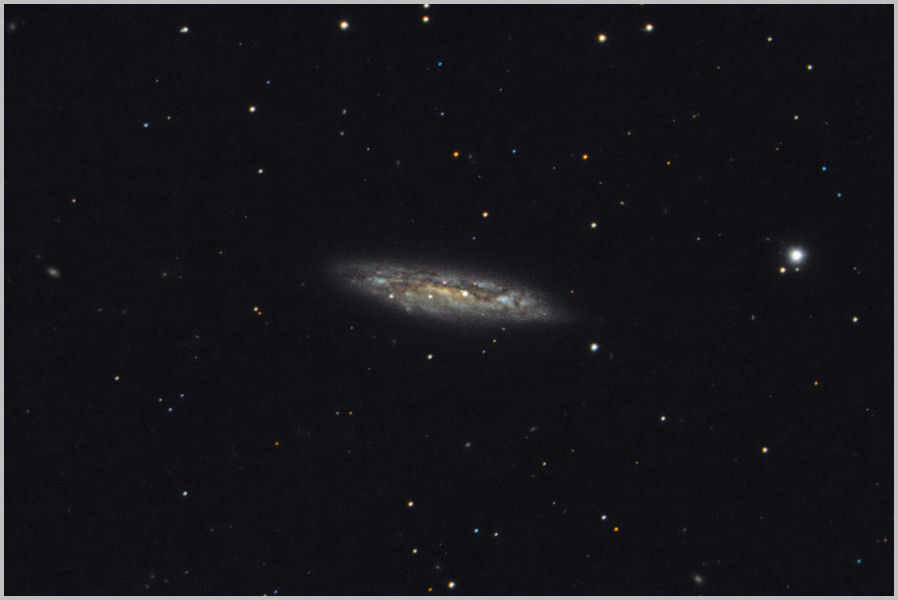
Close to the star Phad is the barred spiral M109, about 45 million light years away, with a magnitude of 9.8.
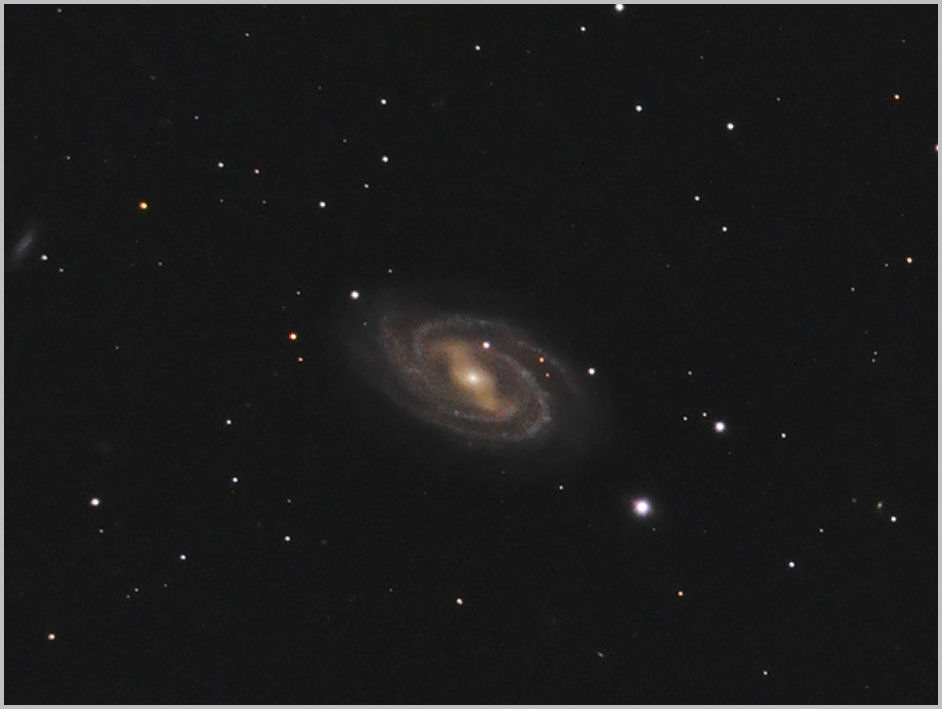
|
|
|
|
|
|